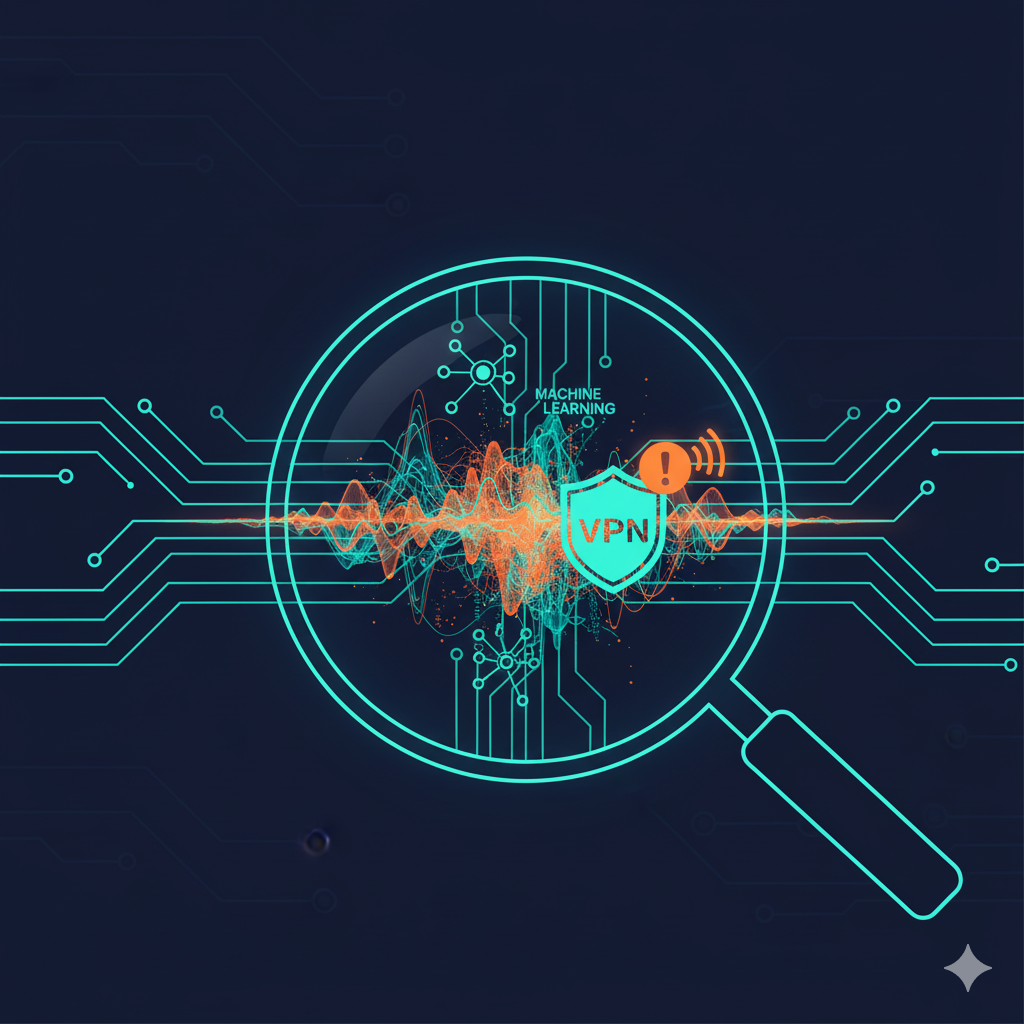Recent research shows machine learning can reliably detect VPN traffic even when payloads are encrypted and application-level DPI fails. By extracting time-frequency features using wavelet transforms and feeding them to models such as Random Forests and neural networks, authors report near-perfect classification between VPN and non-VPN flows — a finding with implications for network operators, privacy advocates, and anyone relying on VPNs to hide traffic characteristics.
What the research did (short overview)
The paper “Binary VPN Traffic Detection Using Wavelet Features and Machine Learning” evaluates whether flows are VPN-tunneled or not regardless of the application inside the tunnel. Instead of payload inspection, the study uses wavelet decomposition to capture temporal patterns in traffic — burstiness, inter-packet timing, and frequency components — then trains models (Random Forest, Neural Networks, SVM). The authors tested different decomposition levels and dataset filtering to measure robustness. The standout result: Random Forest achieved an F1 score ≈ 99%, with neural networks close behind.
Why wavelets help detect VPN traffic
Wavelet transforms decompose a signal into localized time-frequency components, which is ideal for non-stationary network flows that mix short bursts and long idle periods. VPN encapsulation changes the observable flow patterns — packet timing, aggregated sizes, and pacing — in ways that wavelet features can capture even when payloads are fully encrypted. That gives ML models high-quality signals to learn from without ever reading packet contents. This approach has precedent: several recent studies find time-domain and wavelet-based features improve encrypted traffic classification.
Key results & model behavior
Random Forest (RF): Top performer with F1 ≈ 99%, robust to dataset filtering and reduction.
Neural Networks (NN): Nearly as good — F1 ≈ 98% at deeper wavelet levels (e.g., level 12), but with higher training cost.
SVM: Good initial accuracy but more sensitive to dataset filtering; F1 dropped notably when examples were scarce.
Other literature echoes strong performance for time-aware models: a Time-Constrained Classification (TCC) effort and MDPI-published work show accuracies in the high-90s for similar encrypted/VPN classification tasks, though they emphasize trade-offs between computational cost and real-time feasibility.
Practical implications: who benefits — and who loses?
Network operators & defenders: Can use such classifiers to flag VPN use for policy enforcement, QoS shaping, or detecting covert channels. For enterprises, detecting unauthorized VPNs on corporate networks helps enforce acceptable-use policies.
Censors and ISPs: The same methods can be used to identify and block VPN flows — a privacy concern for users in repressive jurisdictions.
VPN providers & privacy advocates: Need to respond by designing traffic-morphing, padding, or timing obfuscation techniques to evade ML detectors; however, obfuscation often costs bandwidth and latency. Research suggests many obfuscation schemes are eventually detectable when adversaries train on realistic variants.
Limitations & caveats of current studies
Dataset bias & generalization: High scores may reflect particular datasets; models can overfit to vendor-specific client behaviors. Robustness testing (cross-dataset, adversarial examples) is essential before real-world deployment.
Real-time constraints: Deep wavelet decomposition and complex models increase CPU cost. Some approaches trade a little accuracy for much faster inference to work at line rate.
Evasion is possible (with cost): VPNs can add padding, jitter, or constant-rate tunneling to hide signatures — but these hurt performance and may be detected as anomalous. The arms race between detectors and evasion continues.
Expert perspective & future research directions
The body of recent work — from wavelet-based studies to transformer/time-wavelet fusion models — shows the field maturing quickly. Survey papers and reviews recommend: standardized benchmark datasets, public adversarial evaluation, and research into low-overhead defenses for user privacy. In short: detection works well today under controlled conditions; the next step is moving methods to robust, privacy-respecting, real-world deployments.
Learn more than Google Play to Verify Privacy-First VPNs with “Verified” Badge
Conclusion
Machine learning combined with wavelet-based feature extraction can detect VPN traffic with very high accuracy, according to recent peer-reviewed and preprint research. The result matters: operators gain powerful tools for traffic classification, while VPN providers face renewed pressure to harden against signature-based ML detectors. The findings are significant, but they also expose an active arms race — detection improves, defenses adapt, and the balance between privacy and network control will continue to shift. If you rely on VPNs for privacy, expect this to be an area of rapid innovation — both for detection and for stealthier tunneling techniques. (arXiv)
Selected sources for verification
Razooqi & Pekár — Binary VPN Traffic Detection Using Wavelet Features and Machine Learning (arXiv / PDF). (arXiv)
MDPI — A Novel Wavelet Transform and Deep Learning-Based Approach to Encrypted Traffic Classification. (MDPI)
Time-Constrained Classification of VPN and non-VPN traffic (Springer / ACM). (dl.acm.org)
Survey papers and reviews on ML-based VPN traffic detection. (ResearchGate)



